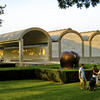More about The Torment of Saint Anthony
- All
- Info
- Shop

Contributor
My dude Michelangelo was way ahead of this time.
He did some seasoned veteran work at ages that would make anyone feel inadequate. His frescoes in the Sistine Chapel were done in his thirties, his statue David— one of the most recognizable sculptures in the world—was done in his mid-twenties. And that painting you’re looking at right now, the one that looks like Julian Assange is being attacked by the creatures from Aaahh!!! Real Monsters, homie painted that as a tween! It’s okay to feel attacked. I do too.
The Torment of St. Anthony is a painting ripped right out of the Bible. Matthew 19:21 to be exact. The story is about a Saint named Anthony who just wants to be a good guy and spread the love. But the devil ain’t about that life so he tries to tempt good ol’ Anthony to the Darkside. Ever the saint, Anthony doesn’t give in. The power of his concentrated goodness allows him to levitate while in prayer, prompting demons from hell to swarm after him. And that pivotal moment in the tale is exactly what Michelangelo felt compelled to paint.
Again, this dude was like twelve when he decided to take brush to canvas. Imagine finding out your annoying pre-teen neighbor designed the movie poster for Avengers Endgame. Referencing a story that well known with a craft so polished at such a young age is phenomenal to say the least. And to take it to another level, The Torment of St. Anthony was kinda ripped from an earlier etched version of the same scene by German artist Martin Schongauer. Twelve year old Michelangelo saw that original etching and said “Alright, hold my beer that I can’t drink.” And then created what is regarded as his earliest masterpiece. What a flex.
He really looked at Schongauer’s etching—with pimples on his face—and decided it needed more. He took the central idea, and added layer after layer that made the biblical tale truely come to life. Two of those things were the colors, and the use of a foreground and background. The color breathes life into the picture that the etching didn’t have, and the use of a foreground and background places the audience in the scene; suddenly other aspects of the painting feel more realistic. The title holds a lot of weight as well. Especially when often times you get titles like “Untitled, 1947”, or “Self Portrait #3”. It’s a title that packs just as much power as the painting itself as it instantly sets you up for what’s to come. If you’re familiar with the story, you’ve already got an idea. But then the painting winds up being better than anything you could have imagined.
All of that feeds into why Michelangelo was such a genius. It’s that kind of attention to detail that set him apart from virtually everyone in his time. And it’s incredible to still have one of his earliest polished works to look at as the standard that was set for him at an age when most of us are still trying to stop picking our noses in public.
Sources
- Baker, R.C. “Spectacle Joins Gravitas at the Met’s Monumental Michelangelo Show.” The Village Voice. November 17, 2017 https://www.villagevoice.com/2017/11/17/spectacle-joins-gravitas-at-the… al-michelangelo-show/
- Rummelsburg, Steven. “The Torment of St. Anthony.” Integrated Catholic Life. December 27, 2013. http://www.integratedcatholiclife.org/2013/12/rummelsburg-the-torment-o…
- The Art Story. “Michelangelo.” Accessed April 27, 2019. https://www.theartstory.org/artist-michelangelo-life-and-legacy.htm
Featured Content
Here is what Wikipedia says about The Torment of Saint Anthony
The Torment of Saint Anthony (or The Temptation of Saint Anthony, c. 1487–88) is a painting by Michelangelo, who painted this close copy of the famous engraving by Martin Schongauer when he was only 12 or 13 years old. Whether the painting is by Michelangelo is disputed. This painting is now in the Kimbell Art Museum in Fort Worth, Texas. It shows the common medieval subject, included in the Golden Legend and other sources, of Saint Anthony (AD 251 – 356) being assailed in the desert by demons, whose temptations he resisted; the Temptation of St Anthony (or "Trial") is the more common name of the subject. But this composition apparently shows a later episode where St Anthony, normally flown about the desert supported by angels, was ambushed in mid-air by demons.
Check out the full Wikipedia article about The Torment of Saint Anthony


















